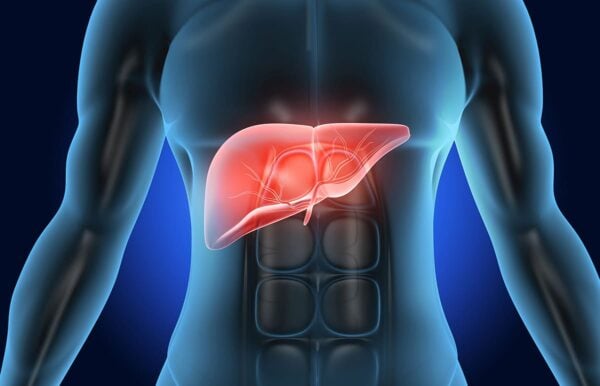The liver is an important organ and should be included in the annual physical exam. If there is a tumor or mass, it should be removed quickly by a medical specialist. Nowadays, laparoscopic surgery combined with Enhanced Recovery After Surgery Program (ERAS Program) helps patients recover quicker to return to their normal lives sooner.
The Importance of the Liver
The liver is a large single organ, which humans cannot live without. It is next to the right diaphragm underneath the rib cage. Its components include the veins and arteries with the gallbladder on the underside. Some may think that the liver and the pancreas are the same organ because in Thai language, they seem like the same, but in fact, the liver and pancreas have completely different function and disorder, even though they are located close together and have related functions. Surgical treatment of both the liver and pancreas is more complicated than other abdominal organs.
The Function of the Liver
The liver has many important functions for the human body. Its main roles are to
- Make cholesterol, which is necessary for hormone productions.
- Make protein, change sugar to glycogen for storage so that it can be released when the body needs it.
- Detoxify by keeping the good nutrients and getting rid of wastes so that blood flow does not carry them to the heart and other parts of the body.
- Make bile to digest fatty food so it is easier for the intestines to absorb.
- Synthesize amino acids, without which the body cannot function properly.
Liver Regeneration
The liver is the only organ in the body which cells can be regenerated. However, blood vessels and bile ducts cannot be regenerated. Some may mistakenly imagine that the liver can regenerate itself like a gecko’s tail. In reality, it will not be the same as before, but rather, just large enough so that the patient can function normally. Therefore, surgical removal of a portion of the liver can be done in healthy people with normal liver function without signs of cirrhosis, inflammation, fibrosis, or fatty liver. In fact, 70 – 75% of the liver can be removed and the remaining portion can still have enough function for the body and regenerate new liver cells. However, if there are signs of aforementioned disorder, the regenerated liver cells will not be good enough and only a small portion, if any at all, can be surgically removed.
Conditions That Lead to Liver Degeneration
Fatty liver, liver cirrhosis, inflammation, or fibrosis will cause liver degeneration and no recovery. If fatty liver affects a large area, it will prevent liver cell regeneration, such that it cannot recover normal function. Fatty liver can be treated with exercise in conjunction with dietary control. Currently, medications are available to reduce liver inflammation due to fatty liver with good results in the case that diet, exercise, and lifestyle modifications are not successful. The physician will monitor liver condition through blood work, ultrasound, and fibroscan.
Common Liver Masses That May Require Surgery
- Hemangioma is a type of mass that is commonly found in the liver. It usually does not have any symptoms and treatment might not be necessary, especially if it is small enough. Treatment is only considered when the mass is large. Hemangioma does not cause any problem and has almost no chance of turning cancerous.
- Focal Nodule Hyperplasia (FNH) is a type of benign tumor, approximately 3–5 centimeters in size. Differential diagnosis from malignant tumor can be done with CT scan or MRI, with the latter being more precise.
- Hepatocellular carcinoma (HCC) is commonly found in patients who had history of some liver disease, such as hepatitis virus infection (HBV, HCV) and alcohol-induced cirrhosis. Therefore, patients who are at risk should get an ultrasound every 6 months to screen for early liver cancer detection, because the sooner a patient knows, the quicker treatment can begin and the chance of a cure increases.
- Cholangiocarcinoma (CCA) is an aggressive type of cancer. Most patients are presented when the condition is quite advanced, making it a challenge to treat. In Thailand, it is usually found in Northeastern population, mainly because of the correlation with eating half-cooked food, particularly freshwater fish that has been infected with liver fluke, which is the main cause of cholangiocarcinoma.
- Metastasis of other tumors to the liver. Most people believe that if cancer has spread to the liver, it cannot be treated. However, liver metastasis can now be treated if it is not widespread. Surgery combined with chemotherapy increase the chance of a cure and longer survival.
- Peri-hilar CCA is a type of cholangiocarcinoma that requires liver surgery as well. This is because peri-hilar CCA tends to spread to the liver. It is commonly found in Northeastern Thai population due to their preference for half-cooked food.
- Gallbladder cancer is rare, but has aggressive and poor prognosis similar to CCA. It has a tendency to spread to the liver, which requires surgical removal of the affected liver as well.
Symptoms of Liver Disease
Early-stage liver disease often does not have any signs. Should there be some signs, it often indicates that the condition is advanced. Thus, annual checkup which consists of physical exam, blood work, and upper abdominal ultrasound is crucial. Observable symptoms include:
- Jaundice, yellow tint in the cornea
- Redness in the palms, especially around the thumbs and the pinkies
- Parotid glands enlargement in men who can develop breasts and red spots
- Swollen legs due to low blood protein level
- Dark color urine
- Bloody vomiting
- Liver cirrhosis and palpable spleen enlargement
- Palpable liver mass under the right rib cage
- Abdominal fluid, abdominal bloating with possible gurgling sound when jiggled
- Patients with chronic liver disease will have abnormal hormone levels.
Worry-free Liver Surgery
Current technology allows effective liver surgery with low risk of complication than before because:
- Liver surgery planning technology allows doctors to map out the surgical path by using X-ray computer to analyze the mass and blood vessels in 3D. Surgical simulation can be done to determine how best to proceed to maximize treatment outcome.
- Liver function test eases worries about the mass. The only concern for doctors is to determine whether enough normal liver can be conserved for normal bodily functions. Current technology can measure liver function thoroughly, compared to just looking at blood tests in the past, which can be erroneous. By using indocyanine green fluorescence dye (ICG) injection, doctors can determine each patient’s liver function within 15 minutes. If the fluorescence signal is high, it indicates that the liver cannot properly metabolize the dye. In normal people, there should not be more than 15% of the fluorescence signal left.
- Laparoscopic liver surgery uses high definition 4K ICG dye navigation to locate precise location. The combination of the surgeon’s expertise and advanced medical equipment and hospital staff allows successful surgery as planned and quick patient recovery.
ADVANCED MIS
The liver is a large organ that can be split into lobes just like an orange, except the lobes are not as clear as oranges. The doctor follows the blood vessels to separate each lobe. Therefore, liver surgery is quite diverse depending on the course of disease. Mid-lobe surgery is more complicated than either end of the liver. In the past, an open surgery under the right rib cage is necessary. Today, small laparoscopic surgery can be performed, which leads to less pain, quick recovery, and quick return to daily living.
There are three types of laparoscopic surgery:
- Pure Laparoscopic Surgery requires several small 5 mm incisions to be made so that surgical tools can be inserted. If a special tool is necessary, the incision can be as large as 10 – 12 mm. Usually, 5 – 6 incisions are necessary, depending on the degree of difficulty of the surgical procedure.
- Robotic-Assisted Surgery allows surgeons to use a console to direct surgery. The most popular type is the DaVinci Robotic System.
- Hybrid/Hand-Assisted Surgery uses small incisions in conjunction with one large open surgery so that surgeons can assist manually.
A limitation for laparoscopic surgery is that should there be excessive bleeding, it will be difficult to control and surgery may need to be aborted. Therefore, surgeons will need to minimize bleeding. A technique to increase surgical area is to introduce air into the abdomen, which will push the abdomen higher and press on the blood vessels to prevent bleeding (in contrast to lack of aid in open surgery, resulting in more blood loss). This makes laparoscopic surgery more attractive as well as the fact that the incisions are much smaller than open surgery. Patients feel less pain, can move around quicker, gain intestinal function and appetite, leading to quicker recovery and discharge. Surgeons will also use dissolvable sutures, which also contributes to quicker recovery and discharge time. However, if the mass is malignant, the incisions may be larger but most of the time, the surgeon will hide the scars underneath the waistline, just like C-section.
Surgical Tools and Gadgets for Liver Surgery
- Cavitron Ultrasonic Surgical Aspirator (CUSA) is an advanced tool that uses low ultrasound frequency to accurately debulk the liver mass without damaging important blood vessels. It is popular among surgeons as it allows for smooth surgery.
- Smart Bipolar Device clamps down on the blood vessels and closes them completely with the inherent scissors function. Currently many tools are being developed to combine necessary types into one.
- Harmonic Scalpel uses high frequency ablation and laser function. It comes with wireless and cable so surgeons don’t have to worry about cable entanglement which increases ease of use and facilitate smooth surgery.
Benefits of Laparoscopic Liver Surgery
- Less blood loss
- Lower risk of complications
- Reduction of pain medications, less pain and suffering
- Less fibrosis
- Quick return to eating
- Reduced hospital stays
- Reduced pain after surgery
- Quick surgical procedure
ERAS: ENHANCED RECOVERY AFTER SURGERY PROGRAM
ERAS Program helps patients recover quicker to return to their normal lives sooner.
At Bangkok Hospital, we care about each patient’s quality of life. That is why we developed a comprehensive care program for our surgical patients. The goal is to go beyond the standard surgical care and aims for quicker recovery, less stress before surgery, less pain after surgery and less side effects from anesthesia during surgery.
To enhance smooth recovery so that patients can go back to their daily routine, Bangkok Hospital’s ERAS program starts before surgery with individual assessment by a multidisciplinary team of medical specialists consisting of surgeons, nurses, nutritionists, and physical therapists, among others, to layout the treatment plan and provide information to each patient and their family. During surgery, the anesthesiologist will choose the method that has the least side effects resulting in less nausea and vomiting post-surgery. The surgeon will choose the right technology that will reduce blood loss and the need for catheters so that the patient can easily regain mobility. After surgery, physicians will use sufficient pain medication to make the patient comfortable. Physical therapist will induce mobility, which permits the patient to begin food intake quickly so that they do not have prolonged thirst and hunger. Once all tubes have been removed, the patient can move with comfort and induces normal bodily functions.
If liver surgery is necessary, do not hesitate and get medical attention immediately. Current technology allows small incisions which are less painful, yet recovery is quicker with low risk of complications. The combination of surgery and ERAS program enhances treatment outcome and patients can return to their normal routine quicker.
Link to package https://www.bangkokhospital.com/page/be-stong-for-surgery








